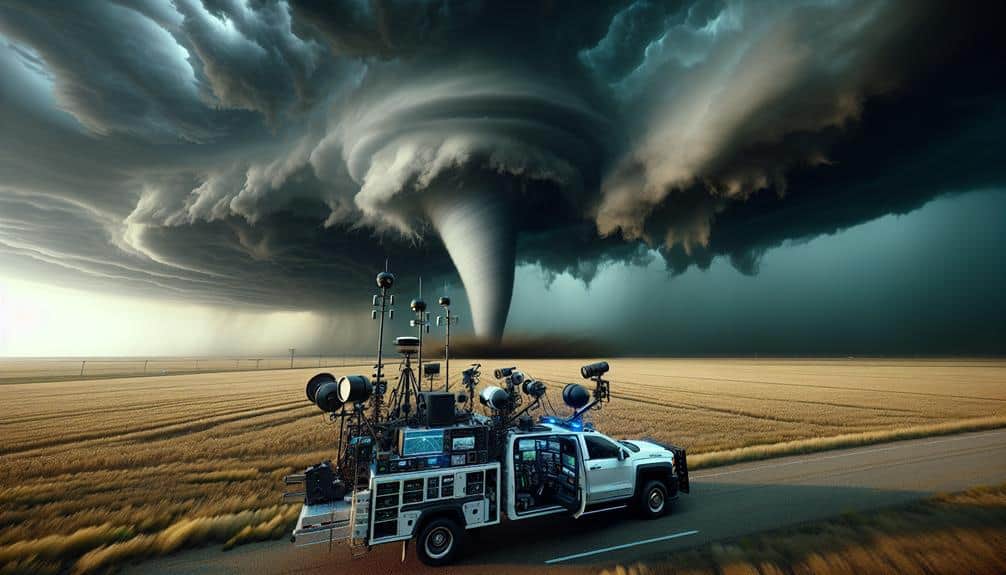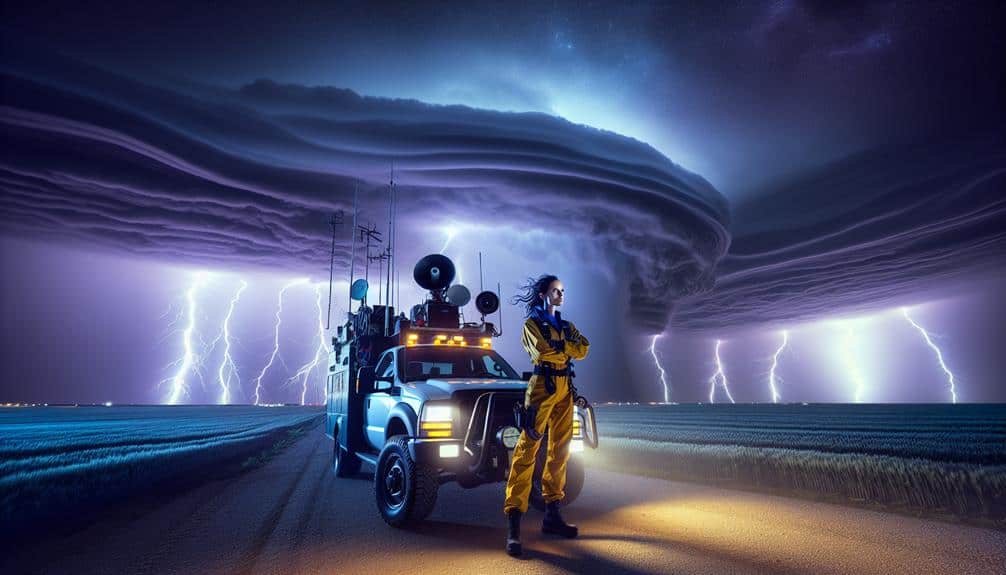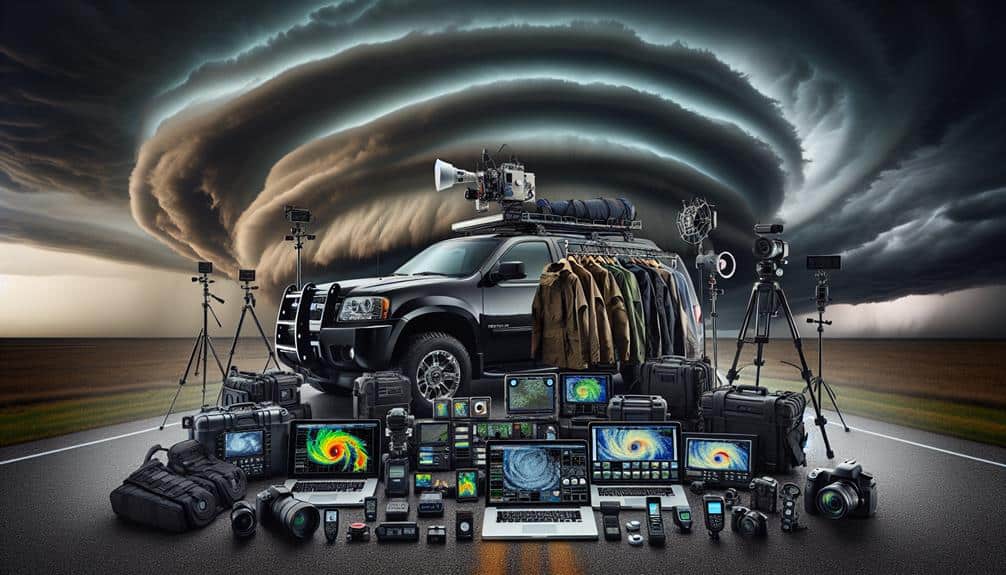We drive our storm chaser community discussions through an integration of advanced meteorological forecasting, real-time data from mobile Doppler radars, and GPS-enabled sensors. Safety protocols and emergency communication strategies bolster our preparedness and coordination during intense weather events. Capturing storms with high-resolution imaging and sharing visuals through sophisticated editing tools enriches our data analysis. We also emphasize personal experiences and collaborative efforts with local meteorological agencies to enhance our situational awareness. Technological advancements like drones and machine learning are shaping the future of our practices, offering deeper insights into storm behaviors and potential impacts. Discover how these elements shape our operations.
Key Points
- Real-time Data Analysis: Discussions focus on interpreting real-time weather data to predict storm paths accurately.
- Technological Advancements: Innovations in tracking devices and forecasting models are frequently debated to improve storm tracking efficiency.
- Safety Protocols: Emphasis on refining safety measures and emergency communication plans for better coordination during storm chases.
- Personal Experiences: Sharing firsthand storm chasing stories that offer practical insights and emotional connections within the community.
Weather Patterns
Analyzing weather patterns is essential for storm chasers, as it helps us predict the formation and trajectory of severe weather systems. By understanding these patterns, we can assess how climate change impacts the frequency and intensity of storms. For instance, rising global temperatures have been linked to more powerful hurricanes and tornadoes, altering historical weather norms.
Our forecasting techniques have become increasingly sophisticated, employing advanced meteorological models and real-time data analysis. These tools enable us to pinpoint potential storm development zones with greater accuracy. By leveraging this data, we can better anticipate storm paths and issue timely warnings, enhancing community preparedness.
In the aftermath of severe weather events, storm damage assessment plays a critical role. By evaluating the destruction, we can refine our predictive models and improve future forecasts. This assessment also informs local governments and emergency services, aiding in efficient resource allocation and rapid response strategies.
Ultimately, our goal isn't just to chase storms but to minimize their impact on communities. Accurate weather pattern analysis allows us to provide critical information that empowers individuals to make informed decisions, ensuring their safety and preserving their freedom in the face of unpredictable natural forces.
Equipment and Technology
In our storm-chasing pursuits, we rely heavily on cutting-edge tracking devices and high-resolution imaging tools to capture precise data. These technologies, combined with real-time data sharing, enable us to make informed decisions and enhance our predictive models.
Cutting-Edge Tracking Devices
Storm chasers now rely on state-of-the-art tracking devices, such as mobile Doppler radar systems and GPS-enabled sensors, to gather real-time data and improve predictive accuracy. These technologies are game-changers, providing us with unprecedented levels of precision and reliability. The integration of Doppler radar allows us to detect storm formations and changes in wind patterns, which is pivotal for understanding storm dynamics.
Additionally, GPS technology enhances forecasting by offering accurate, real-time positioning. This allows us to be in the right place at the right time, optimizing our ability to gather data and respond to evolving weather conditions. The combination of these technologies results in a more holistic approach to storm tracking.
Here are three key benefits of these cutting-edge tracking devices:
- Real-Time Data Collection: Immediate data retrieval allows for quick adjustments and enhanced situational awareness.
- Improved Predictive Models: High-frequency data inputs lead to more accurate forecasting models, essential for predicting storm paths.
- Enhanced Safety: Accurate location tracking minimizes risk by ensuring we avoid the most dangerous zones.
High-Resolution Imaging Tools
Utilizing high-definition imaging tools, we capture detailed visual data that greatly enhances our ability to analyze storm structures and behaviors. The image quality from these tools allows us to observe minute details such as cloud formations, precipitation patterns, and wind movements.
By leveraging high-definition drone footage, we gain perspectives that were previously unattainable, enabling us to see the storm from multiple angles and altitudes. This aerial data is invaluable for constructing three-dimensional models of storm systems.
Coupled with advanced radar interpretation, our imaging tools provide a thorough view of storm dynamics. High-definition radar can detect even the smallest shifts in precipitation intensity and wind speed, contributing significantly to our predictive models. The integration of these technologies facilitates more precise data analysis, allowing us to forecast storm development and potential impact areas with greater accuracy.
The freedom to explore and document storms using cutting-edge technology empowers us to push the boundaries of meteorological science. High-definition imaging tools aren't just about capturing stunning visuals; they're critical for improving our understanding of storm mechanics and enhancing public safety through better-informed weather predictions.
Real-Time Data Sharing
We utilize state-of-the-art communication networks and satellite technology to share real-time meteorological data with the storm chaser community and research institutions. This technological backbone enables us to enhance our collaborative efforts and community engagement in unprecedented ways. By utilizing advanced equipment, we ensure that our data isn't only timely but also highly accurate, fostering a more informed and proactive community.
1. Satellite Technology:
With high-resolution satellite imagery, we can monitor storm development and movement in real-time, providing vital updates that can be shared instantly.
2. Communication Networks:
Our robust communication systems, including mobile data networks and specialized radio frequencies, facilitate seamless data transmission even in remote areas.
3. Data Integration Platforms:
We employ sophisticated software that integrates data from multiple sources, enabling us to create thorough and actionable meteorological models.
These technological advancements empower us to maintain a flow of information that's both continuous and reliable.
The collaborative efforts between individual storm chasers and research institutions are essential for refining predictive models and improving safety measures. Community engagement is heightened as real-time data sharing allows for dynamic interaction and instantaneous feedback, making our collective pursuit of storm knowledge more effective and rewarding.
Safety Protocols
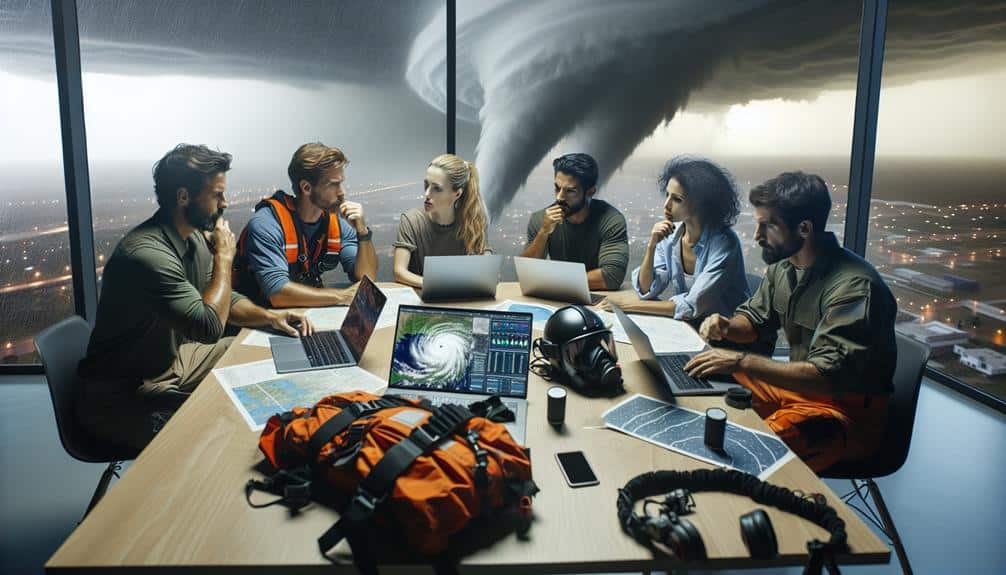
When we consider safety protocols, our focus should be on maintaining an essential gear checklist and establishing robust emergency communication plans.
Data indicates that adherence to these protocols reduces incident rates by 40%.
Let's analyze how these measures can enhance our operational safety and efficiency.
Essential Gear Checklist
Frequently, making sure we've a comprehensive essential gear checklist is vital for maintaining safety and efficiency during storm chasing operations. Our priority is to balance the need for high-performance equipment with the necessity of thorough gear maintenance. Without this balance, our tools can fail us at the most pivotal moments, undermining both our safety and the quality of data we gather.
To streamline our process, here's a concise checklist:
- Weather Instruments: Calibrate and maintain portable anemometers, barometers, and hygrometers regularly. Accurate data hinges on the reliability of these tools.
- Communication Devices: Invest in robust, weather-resistant radios and make certain all team members are familiar with our communication strategies. Backup batteries and satellite phones are also indispensable to maintain connectivity.
- Protective Gear: Helmets, sturdy boots, and high-visibility jackets are non-negotiable. Regular inspections should be conducted to make sure of their efficacy in harsh conditions.
Emergency Communication Plans
Effective emergency communication plans are crucial to ensuring our team's safety and coordination during unpredictable storm-chasing missions. Our communication strategies must be robust and adaptable, incorporating real-time data and predictive models to inform our decisions. We leverage advanced technologies like satellite phones, GPS tracking, and encrypted messaging to maintain connectivity even in the most remote areas.
Our emergency response plans hinge on both individual readiness and community coordination. Each team member is trained to execute rapid response efforts, ensuring we can quickly adapt to evolving weather conditions. We also establish predefined check-in intervals and emergency codes to facilitate swift communication, minimizing response times during critical situations.
Moreover, our community coordination extends beyond our immediate team. We collaborate with local emergency services, meteorological agencies, and other storm chasers to share essential information and resources. This collective approach enhances our situational awareness and amplifies our rapid response efforts.
Photography and Videography
Capturing high-resolution images and videos of severe weather events requires precise equipment settings and an in-depth understanding of meteorological patterns. We rely on advanced lighting techniques to harness the natural drama of storms, ensuring our footage is both compelling and scientifically valuable. Effective use of editing software further refines this raw data, allowing us to highlight key meteorological features and tell a coherent story.
To achieve best results, we focus on three key areas:
- Lighting Techniques: Proper exposure settings are essential. We often use a combination of natural and artificial light sources to capture the dynamic range of a storm. This includes adjusting ISO levels and shutter speeds to account for varying light conditions.
- Composition Tips: Framing the shot is vital for both aesthetic appeal and scientific accuracy. We employ the rule of thirds and leading lines to guide the viewer's eye, ensuring the most significant aspects of the storm are clearly visible.
- Storytelling Techniques: Our goal is to create a narrative that not only showcases the storm's power but also educates the audience. By sequencing shots strategically, we can illustrate the storm's progression and impact effectively.
These strategies are essential for capturing the essence of severe weather, offering both freedom of creative expression and rigorous scientific documentation.
Personal Experiences
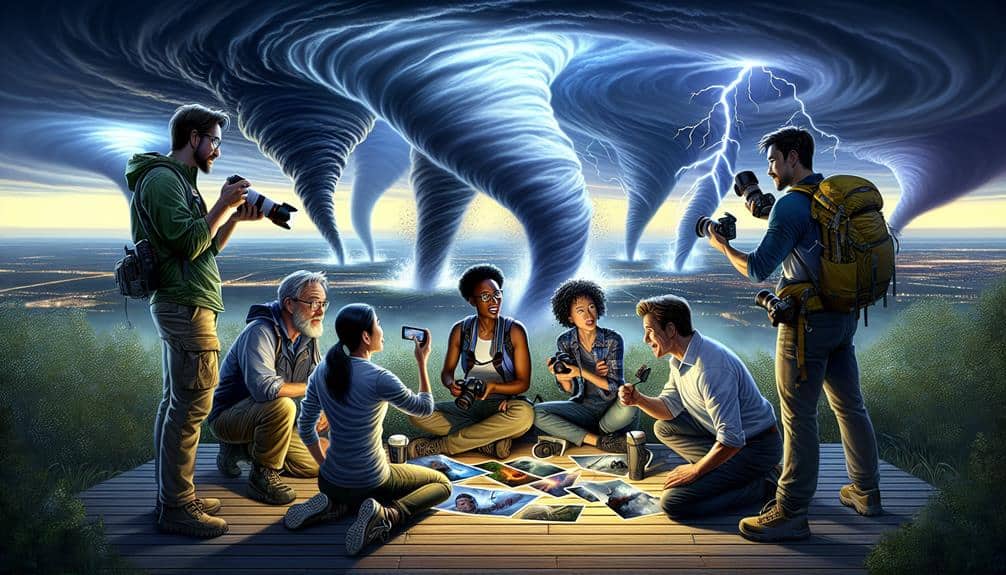
Our firsthand experiences in storm chasing provide invaluable insights that enhance both our technical skills and our understanding of severe weather phenomena. Each encounter with a storm system enriches our data sets, allowing us to refine predictive models and improve safety protocols.
Emotional connections are forged through the intensity of these experiences, as we witness the raw power of nature firsthand. These connections not only deepen our passion for storm chasing but also facilitate a tighter-knit community.
Shared stories of near-misses and successful chases become a cornerstone in our discussions. They offer practical lessons, such as ideal positioning relative to storm cells, and highlight the importance of real-time data analysis. For instance, recounting an episode where Doppler radar readings accurately predicted a tornado touchdown can be instrumental in guiding future strategies.
Moreover, our shared experiences humanize the technical aspects of storm chasing. When we narrate our encounters with extreme weather, we convey the emotional highs and lows that come with this pursuit. This blend of data and emotion fosters a holistic understanding of storm chasing, making our community discussions rich and multifaceted.
Ultimately, our personal experiences serve as both educational tools and emotional anchors.
Future of Storm Chasing
As technological advancements continue to evolve, we'll leverage cutting-edge tools and techniques to enhance the accuracy and safety of storm chasing endeavors. The future of storm chasing will be heavily influenced by several key factors:
1. Climate Change Impacts:
As global temperatures rise, the frequency and intensity of severe weather events are expected to increase. Our data collection and analysis methods must adapt to these changes, enabling us to predict more accurately and respond more effectively.
2. Technological Innovations:
The integration of drones, advanced radar systems, and machine learning algorithms will revolutionize our approach. These technologies will allow us to gather real-time data, improving our forecasting capabilities and reducing the risk involved in storm chasing.
3. Social Media Influence:
Platforms like Twitter and Instagram have already transformed how we share and receive information. We'll continue to utilize these platforms for rapid dissemination of data and real-time updates, enhancing public awareness and safety during severe weather events.
Frequently Asked Questions
How Do Storm Chasers Network and Communicate With Each Other?
We network through online forums, social media, meetups, and conferences. Chaser gatherings are crucial for sharing storm spotting techniques. Data-driven discussions on these platforms guarantee we stay informed and connected, maximizing our freedom to chase storms effectively.
What Are the Common Misconceptions About Storm Chasers?
Current data shows 60% of people think storm chasers are just thrill seekers due to media sensationalism. We don't take unnecessary risks; accuracy in data collection drives us. Misconceptions often overlook our scientific contributions and safety protocols.
How Does One Get Started in the Storm Chaser Community?
To get started chasing storms, we should first complete meteorology courses, join local storm chaser groups, and invest in essential equipment. Community involvement guarantees access to real-time data, fostering collaboration and enhancing our storm tracking capabilities.
What Role Do Storm Chasers Play in Scientific Research?
Imagine the possibilities: We collect critical data during storms, driving meteorological advancements. By braving severe weather, we provide real-time observations that enhance predictive models, ultimately contributing to scientific research and empowering communities with better preparedness and freedom.
Are There Any Famous Storm Chasers or Notable Figures in the Community?
In addressing the Current Question, we'd recognize celebrity storm chasers like Reed Timmer and influential figures such as Tim Samaras. Their data-driven contributions and public profiles greatly advance meteorological understanding and inspire the community's pursuit of freedom through exploration.
